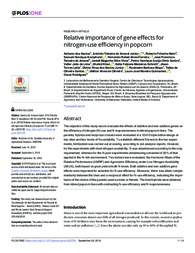Relative importance of gene effects for nitrogen-use efficiency in popcorn.
Relative importance of gene effects for nitrogen-use efficiency in popcorn.
Author(s): SANTOS, A.; AMARAL JÚNIOR, A. T. do; FRITSCHE-NETO, R.; KAMPHORST, S. H.; FERREIRA, F. R.; AMARAL, J. F. T. do; VIVAS, J. M. S.; SANTOS, P. H. A. D.; LIMA V. J. de; KHAN, S.; SCHMITT, K. F. M.; LEITE, J. T.; SANTOS JUNIOR, D. R. dos; BISPO, R. B.; SANTOS, T. de O.; OLIVEIRA, U. A. de; GUIMARAES, L. J. M.; RODRIGUEZ, O.
Summary: The objective of this study was to evaluate the effects of additive and non-additive genes on the efficiency of nitrogen (N) use and N responsiveness in inbred popcorn lines. The parents, hybrids and reciprocal crosses were evaluated in a 10x10 triple lattice design at two sites and two levels of N availability. To establish different N levels in the two experiments, fertilization was carried out at sowing, according to soil analysis reports. However, for the experiments with ideal nitrogen availability, N was sidedressed according to the crop requirement, whereas for the N-poor experiments sidedressing consisted of 30% of that applied in the N-rich environment. Two indices were evaluated, the Harmonic Mean of the Relative Performance (HMRP) and Agronomic Efficiency under Low Nitrogen Availability (AELN), both based on grain yield at both N levels. Both additive and non-additive gene effects were important for selection for N-use efficiency. Moreover, there was allelic complementarity between the lines and a reciprocal effect for N-use efficiency, indicating the importance of the choice of the parents used as male or female. The best hybrids were obtained from inbred popcorn lines with contrasting N-use efficiency and N responsiveness.
Publication year: 2019
Types of publication: Journal article
Unit: Embrapa Maize & Sorghum
Keywords: Gene, Linhagem, Milho Pipoca, Nitrogênio
Observation
Some of Embrapa's publications are published as ePub files. To read them, use or download one of the following free software options to your computer or mobile device. Android: Google Play Books; IOS: iBooks; Windows and Linux: Calibre.
Access other publications
Access the Agricultural Research Database (BDPA) to consult Embrapa's full library collection and records.
Visit Embrapa Bookstore to purchase books and other publications sold by Embrapa.

